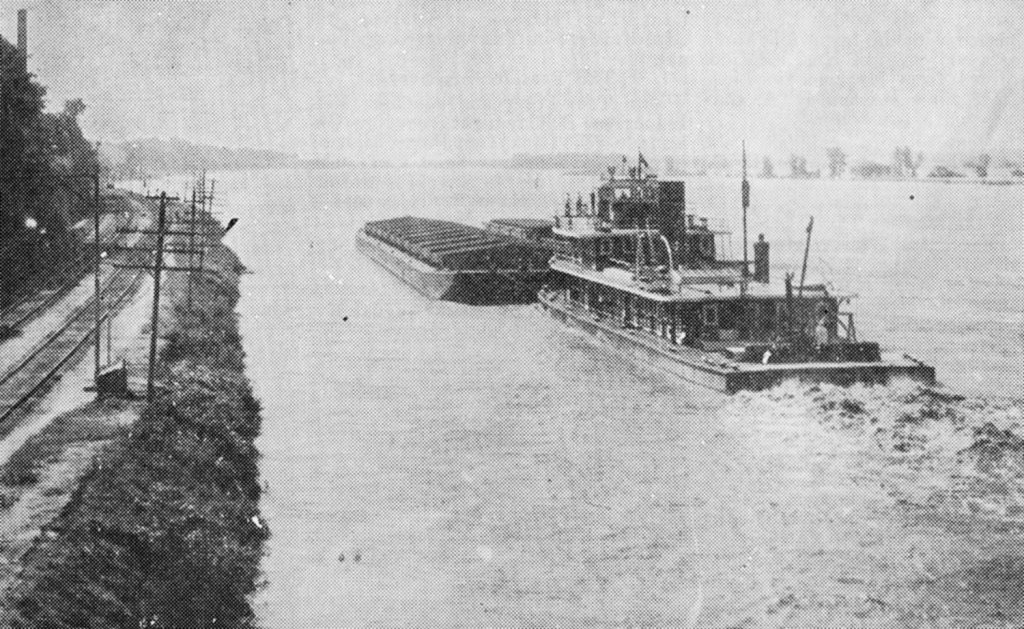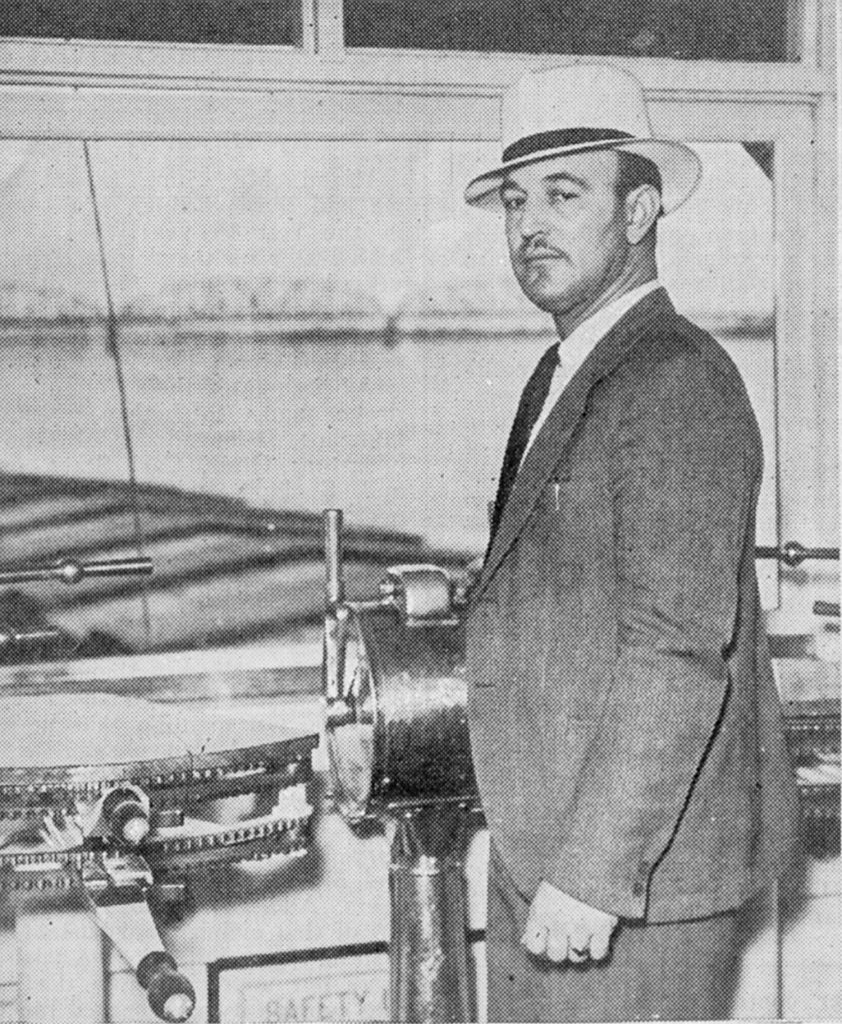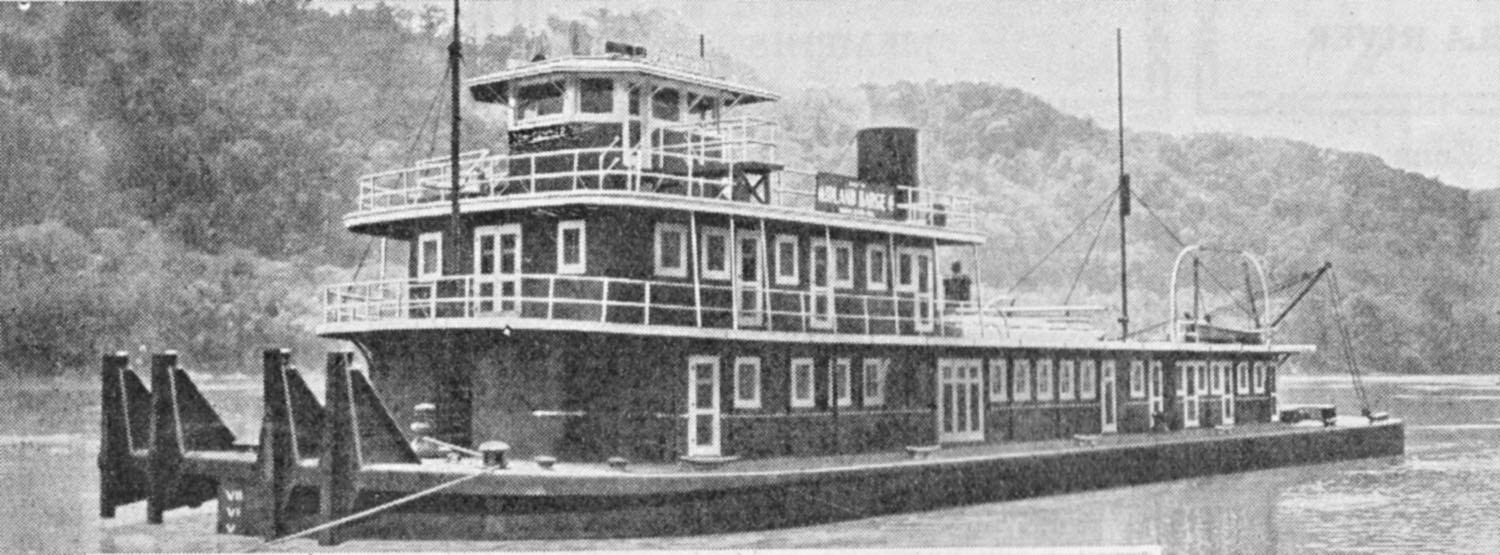About this time each year, those involved in navigation on the Missouri River are anticipating the start of the navigation season. The Corps reservoirs typically release water to support navigation on the stream from the first of April through the end of November each year. With sufficient water entering the Missouri from the tributaries, it is not unusual to have some tows on the move by mid-March. That was the case this year when the Melba L. Engemann of Missouri River Towing entered the mouth with a tow of three loads and four empties on March 7, according to the Missouri River Boat Report put out by the Corps’ Kansas City District.
In 1935, the Inland Waterways Corporation (IWC), typically referred to as the Federal Barge Line, was looking to establish regular barge service between St. Louis and Kansas City. Work had been progressing on dredging and construction of training structures to ensure at least a 6-foot-deep channel on the traditionally problematic Missouri River. In 1932, the IWC had made a trial trip with the sternwheel steamers Mark Twain and General Ashburn as far as Kansas City, and that had gone well. A large crowd greeted the boats at the new Kansas City terminal, but only sporadic trips had been made since. Now it was felt that the channel was ready to support regular service, and the diesel twin-screw Franklin D. Roosevelt would enter that trade.
The Roosevelt had been built by Midland Barge Company, Midland, Pa., in 1933. The steel hull was 148.7 feet by 40 feet, and the boat had 1,180 hp. from a pair of McIntosh & Seymour engines. M&S was then a division of The American Locomotive Company, and it would later be known simply as Alco. The direct-reversing engines turned a maximum 300 rpm. and had eight cylinders, 12-1/2 inch diameter and 22-inch stroke. The twin props were 69 inches in diameter. Capt. Thomas P. Craig of Boonville, Mo., was to be master of the Roosevelt for the Kansas City trip, and he would be assisted by pilots Capt. John F. McIntyre, Capt. William D. Earp (regular master of the U.S. Engineers’ Str. Bixby), and Capt. Abner Friemonth.
The tow would consist of three pieces: a large 300-foot-long barge and two smaller ones. Some 1,000 tons of newsprint had come from Canada to Chicago, where it was loaded in the large barge. According to a story in the June 1, 1935, issue of The Waterways Journal, it was picked up in Chicago and delivered to St. Louis by the William T. Warner, a retractable-pilothouse, diesel prop towboat owned by Warner & Tamble, Memphis, but on charter to the IWC. The other barges contained a variety of cargo that could have been found on an old-time packet; burlap from India, coffee from Central America and sugar from Cuba. Products produced in the U.S. were also in the barges of the tow, including soap, auto motors and axles, agricultural implements, washing machines, roofing felt, pianos and even an amount of beer and whiskey.

The Missouri River had been experiencing what was conversely described as the “worst flood since 1903,” and the “worst flood since 1927.” The WJ of June 8, 1935, detailed the flood conditions, and noted that all channel improvement construction operations were currently postponed. In anticipation of the initial trip by the Franklin D. Roosevelt, a group from the St. Louis Engineers office made an aerial survey of the Missouri from Hermann, Mo., to the mouth. It was estimated some 80,000 acres within this 95-mile stretch were inundated. The Kansas City Star had expressed concern that the Roosevelt might not be able to make it under the bridges at Glasgow, Mo., but the U.S. Engineers had surveyed the area and declared that there was sufficient clearance. The U.S. light tender Wakerobin made a trip from the mouth to Hermann to check navigation conditions and set necessary buoys, the first time it had been on that stream.
The Roosevelt got underway northbound out of St. Louis about daylight on June 7. The Propeller Club held a luncheon at the Hotel Statler later in the day honoring Maj. Gen. Thomas Q. Ashburn, head of the IWC. Speakers at the luncheon included then-U.S. Sen. Harry Truman. Following this event, Gen. Ashburn was taken to St. Charles, Mo., where he caught the Roosevelt. According to reports in the June 8 issue of the WJ, the Roosevelt had trouble shoving through the Wabash bridge and the highway bridge at St. Charles. The Roosevelt later had to double-trip the tow near Lexington, Mo., and again a few miles upstream to negotiate Sni Bend. Even after this, the Franklin D. Roosevelt arrived at Kansas City on schedule on June 14.

As the boat and tow arrived, the towboat John James of Massman Construction, towing a deck barge with a greeting committee aboard, met it 2 miles downstream. Speeches were again made by Sen. Truman, Gen. Ashburn and others. Ashburn remarked that “The opening of the St. Louis–Kansas City line makes St. Louis the center of inland water traffic.” He added, “We expect to make the round trip to Kansas City in one week with the stream normal.” WJ Advertising Manager Andrew Franz was aboard the Roosevelt for the return trip to St. Louis. The boat left at 6:30 p.m. on June 14 with one cargo barge holding some 500 tons of freight, including iron pipe and flour. Running daylight only, it arrived back at St. Louis on June 17. It departed on the second trip up the Missouri on June 20.
The Missouri River traffic for Federal would increase over the years, and boats other than the Roosevelt would run there, though some years later it would deliver the first official payload to Sioux City. In 1953, the assets of the Inland Waterways Corporation were sold to Herman T. Pott/St. Louis Ship and officially named Federal Barge Line. In 1955 the Roosevelt was first leased, then sold to S&S Marine Towing of Joliet, Ill. By 1961 the Inland River Record still listed it as owned by S&S, but the List of Merchant Vessels shows it as being owned by Point Towing, of Pittsburgh. In 1961, the IRR shows that it was operated by Striegel Barge Line, Greenville, the name had been changed to Jess Ready, and it had been repowered with National Superior diesels of 2,000 hp. It disappeared from the IRR after this, but the List continues to show it, and in 1964 it was owned by River Transportation, Point Pleasant, W.Va., which was Capt. Bob Bosworth.
The boat, with upper cabin and pilothouse removed, was later used as a landing boat at Kanauga, Ohio, for Point Towing, and M/G Transport. The name FRANKLIN D. ROOSEVELT could still be seen welded on the bow of the hull. It was at some point sold to Bosworth’s G&C Towing, which utilized it as a headline float for the Henderson, W.Va., main fleet after the remains of the Geo. T. Price had been scrapped. It was eventually sent on a “one-way trip” to Mansbach Metals, Ashland, Ky., where it too was pulled up the bank and scrapped.
Caption for top photo: The mv. Franklin D. Roosevelt new at Midland from McIntosh & Seymour ad in the June 15, 1935, WJ. (David Smith collection)




